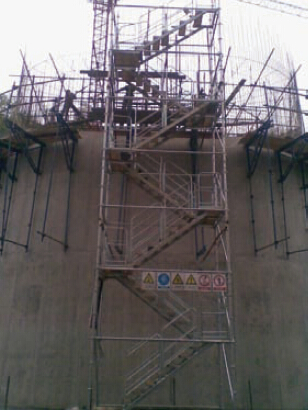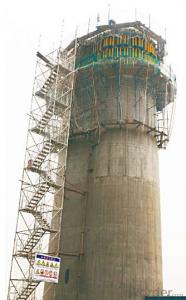Stair Tower for Formwork and scaffolding systems
- Loading Port:
- Tianjin
- Payment Terms:
- TT OR LC
- Min Order Qty:
- 50 m²
- Supply Capability:
- 1000 m²/month
OKorder Service Pledge
Quality Product, Order Online Tracking, Timely Delivery
OKorder Financial Service
Credit Rating, Credit Services, Credit Purchasing
You Might Also Like
Stair Tower
The structure of ring-lock stair tower is the same as Φ60 ring lock scaffolding.
The dimension of cross section is 1500×3000mm.It is widely used in construction.
Bearing Capacity of Stair Tower:
The stair tower can be erected with the maximum height of 150m,
when attached to the wall every 4.5m.


- Q:Can steel formwork be used in precast concrete applications?
- Yes, steel formwork can be used in precast concrete applications. Steel formwork is commonly used in precast concrete construction as it offers durability, strength, and the ability to create complex shapes and designs. It provides a reliable and efficient solution for creating precise and high-quality precast concrete elements.
- Q:Can steel formwork be used in combination with other types of formwork?
- Yes, steel formwork can be used in combination with other types of formwork. In construction projects, it is common to use a combination of different types of formwork to meet the specific requirements of the structure being built. Steel formwork offers several advantages, such as durability, reusability, and high load-carrying capacity. It is often used for large-scale projects or structures with complex geometries. However, steel formwork can be expensive and heavier compared to other types of formwork. In situations where speed and efficiency are crucial, contractors may choose to use a combination of steel formwork with other types of formwork, such as timber or aluminum. This allows for a more cost-effective approach while still maintaining the desired strength and stability. For example, timber formwork may be used for simpler sections of the structure or areas where the load is relatively light. This can help reduce costs and make the overall construction process more efficient. Steel formwork, on the other hand, can be utilized for critical areas that require higher load-carrying capacity or more complex shapes. The combination of different types of formwork also provides flexibility in terms of design and construction methods. By using steel formwork in combination with other types, contractors can optimize the use of resources, minimize costs, and ensure the successful completion of the project. However, it is important to note that when using a combination of formwork types, proper coordination and planning are essential. Contractors need to ensure that the different types of formwork are compatible and adequately supported to maintain structural integrity. Additionally, proper safety measures should be implemented to protect workers during the construction process. Overall, steel formwork can be effectively used in combination with other types of formwork to achieve the desired construction goals, improve efficiency, and optimize resource utilization.
- Q:How does steel formwork affect the overall construction site noise pollution?
- The overall construction site noise pollution can be significantly reduced by steel formwork. Steel formwork offers better acoustic insulation properties compared to traditional wooden formwork. The sound waves are absorbed and dampened by the rigid and dense nature of steel materials, resulting in minimized noise propagation. This is particularly advantageous in densely populated areas or construction sites near residential or commercial areas. In addition, steel formwork is commonly prefabricated, meaning it is manufactured off-site and then assembled on-site. This process reduces construction noise by requiring fewer on-site activities and decreasing the need for cutting, drilling, and hammering, which are major sources of noise pollution. Moreover, the use of steel formwork can lead to faster construction times, resulting in shorter exposure to noise for neighboring communities. Furthermore, steel formwork is more durable and long-lasting than wooden formwork, allowing it to be reused multiple times. This reusability reduces the frequency of formwork installation and dismantling, further decreasing noise pollution generated during the construction process. Overall, the utilization of steel formwork in construction can greatly contribute to the minimization of noise pollution at the construction site. The superior acoustic insulation properties, reduced on-site activities, and longer lifespan all collaborate to create a quieter and more environmentally friendly construction environment.
- Q:Can steel formwork be used for both vertical and horizontal applications?
- Yes, steel formwork can be used for both vertical and horizontal applications. Steel formwork offers the necessary strength and durability to support concrete during pouring and setting, making it suitable for various construction projects regardless of the orientation.
- Q:How does steel formwork contribute to improved construction efficiency?
- Steel formwork contributes to improved construction efficiency in several ways. Firstly, steel formwork is known for its durability and strength. It can withstand heavy loads and extreme weather conditions, allowing construction projects to progress without delay. This means that builders can work at a faster pace and complete their tasks more efficiently. Secondly, steel formwork is reusable. Unlike traditional timber formwork, which often needs to be replaced after a few uses, steel formwork can be used multiple times, reducing the need for constant material replenishment. This not only saves time but also reduces construction costs and minimizes waste. Additionally, steel formwork offers excellent dimensional accuracy and stability. It enables precise shaping and alignment of concrete structures, ensuring that they meet the required specifications and standards. This accuracy eliminates the need for rework or adjustments, saving time and resources. Furthermore, steel formwork is easy to assemble and dismantle. Its modular design allows for quick installation and removal, reducing the time spent on formwork-related activities. This aspect is particularly beneficial when working on large-scale projects, where time is of the essence. Moreover, steel formwork provides a smooth and even finish to concrete structures. This eliminates the need for additional plastering or finishing work, further enhancing construction efficiency. Additionally, the smooth surfaces created by steel formwork are easier to clean and maintain, ensuring a longer lifespan for the structure. Finally, steel formwork offers enhanced safety for construction workers. Its strength and stability minimize the risk of accidents or collapses, providing a secure working environment. This, in turn, leads to increased productivity and efficiency on the construction site. In summary, steel formwork contributes to improved construction efficiency by providing durability, reusability, dimensional accuracy, quick assembly, smooth finishes, and enhanced safety. These factors allow construction projects to progress at a faster pace, reduce costs, and deliver high-quality structures within the desired timeframe.
- Q:How does steel formwork affect the overall sustainability of a construction project?
- The overall sustainability of a construction project can be significantly influenced by the use of steel formwork. Firstly, the durability and reusability of steel formwork greatly reduces the need for constant replacement, resulting in minimal waste generation and a reduced environmental footprint. This not only benefits the project's environmental impact but also aids in cost reduction. Additionally, the use of steel formwork ensures a high level of accuracy and precision, leading to efficient and streamlined construction processes. This in turn reduces material wastage and energy consumption, contributing to the sustainable use of resources. Moreover, the utilization of steel formwork enables faster construction cycles, resulting in decreased overall energy consumption and greenhouse gas emissions. Furthermore, steel formwork offers versatility in design, allowing for the creation of complex and innovative architectural structures. This versatility enhances the aesthetic appeal of a building, promoting its long-term use and decreasing the likelihood of demolitions due to outdated designs. By extending the lifespan of a structure, steel formwork contributes to the sustainability of the project by reducing the need for additional construction and material usage. In addition, steel formwork plays a crucial role in ensuring the overall structural integrity and safety of a building. Its strength and rigidity provide stability during both construction and throughout the lifespan of the structure. This reduces the risk of structural failures and the need for repairs or reconstruction, consequently minimizing waste generation and resource depletion. To summarize, the use of steel formwork has various positive impacts on the overall sustainability of a construction project. Its durability, reusability, precision, efficiency, versatility, and structural integrity contribute to the reduction of waste generation, energy consumption, and greenhouse gas emissions. By promoting the sustainable use of resources and contributing to the long-term viability of buildings, steel formwork plays a crucial role in sustainable construction practices.
- Q:What is the weight of steel formwork panels?
- The weight of steel formwork panels can vary depending on the size, thickness, and design of the panels. On average, steel formwork panels can range from 20 to 30 kilograms per square meter. However, it is important to note that this weight can increase or decrease based on specific project requirements and customization. Additionally, it is advisable to consult with manufacturers or suppliers to obtain accurate and up-to-date information on the weight of steel formwork panels for a particular application.
- Q:How does steel formwork contribute to the overall efficiency of concrete construction?
- Steel formwork contributes to the overall efficiency of concrete construction by providing a durable and reusable framework for pouring concrete. It offers a high level of accuracy and precision in shaping the concrete, ensuring that the desired dimensions and finishes are achieved. This leads to a reduction in material wastage and labor costs. Additionally, the strength and stability of steel formwork allows for faster construction cycles, enabling projects to be completed on time or ahead of schedule.
- Q:Can steel formwork be used for curved or non-standard concrete shapes?
- Yes, steel formwork can be used for curved or non-standard concrete shapes. Steel is a very versatile material that can be easily manipulated into various shapes, making it ideal for forming concrete structures with unique and intricate designs. Unlike traditional wooden formwork, steel formwork can be bent, twisted, and shaped to accommodate any desired curvature or non-standard shape. Additionally, steel formwork offers excellent strength and durability, ensuring that it can withstand the pressure exerted by the concrete during pouring and curing. Therefore, steel formwork is commonly used in construction projects that require curved or non-standard concrete shapes, such as architectural features, decorative elements, or complex structural components.
- Q:Can steel formwork be used for high-rise buildings?
- Yes, steel formwork can be used for high-rise buildings. Steel formwork offers several advantages such as durability, strength, and flexibility, making it suitable for large and complex structures like high-rise buildings. It can withstand the pressure exerted by concrete, ensuring structural stability during the construction process. Additionally, steel formwork allows for smooth and precise concrete finishing, facilitating the construction of high-quality, aesthetically appealing high-rise buildings.
1. Manufacturer Overview |
|
|---|---|
| Location | |
| Year Established | |
| Annual Output Value | |
| Main Markets | |
| Company Certifications | |
2. Manufacturer Certificates |
|
|---|---|
| a) Certification Name | |
| Range | |
| Reference | |
| Validity Period | |
3. Manufacturer Capability |
|
|---|---|
| a)Trade Capacity | |
| Nearest Port | |
| Export Percentage | |
| No.of Employees in Trade Department | |
| Language Spoken: | |
| b)Factory Information | |
| Factory Size: | |
| No. of Production Lines | |
| Contract Manufacturing | |
| Product Price Range | |
Send your message to us
Stair Tower for Formwork and scaffolding systems
- Loading Port:
- Tianjin
- Payment Terms:
- TT OR LC
- Min Order Qty:
- 50 m²
- Supply Capability:
- 1000 m²/month
OKorder Service Pledge
Quality Product, Order Online Tracking, Timely Delivery
OKorder Financial Service
Credit Rating, Credit Services, Credit Purchasing
Similar products
New products
Hot products
Hot Searches
Related keywords
























